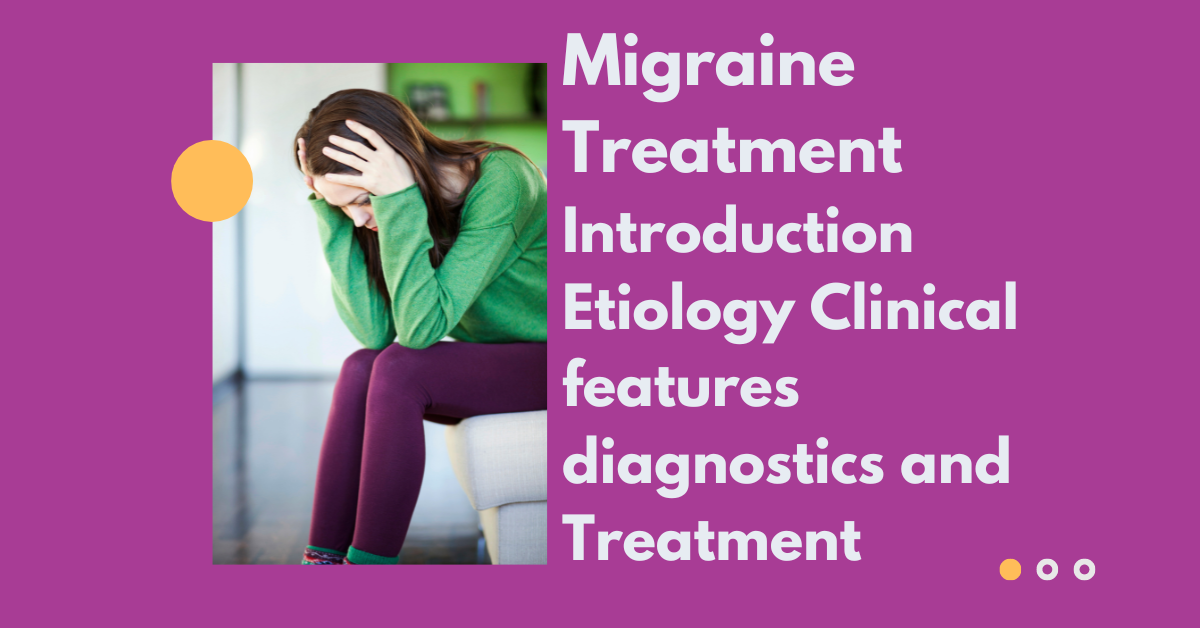Epidemiology
Prevalence: Migraine affects approximately 17% of females and around 6% of males.
Peak Incidence: The peak incidence of migraine treatment is observed in the age range of 30 to 39 years.
Commonality: Migraine treatment stands as the second most prevalent type of headache.
Pathophysiology:
The pathophysiology of migraine is not fully understood. Various factors are thought to contribute to the development and severity of migraine treatment. These factors include:
- Activation of meningeal nociceptors.
- Dilatation of intracranial blood vessels, which subsequently activates meningeal nociceptors.
- Activation of the trigeminovascular pathway, involving the activation of trigeminal neurons leading to the release of vasoactive neuropeptides like substance P or calcitonin gene-related peptide (CGRP), resulting in vasodilatation and the release of proinflammatory molecules such as histamine, bradykinin, serotonin, and prostaglandins, ultimately culminating in neurogenic inflammation and activation of meningeal nociceptors.
- Cortical spreading depression is characterized by the excitation and inhibition of the cerebral cortex, leading to changes in cortical enzymatic activity, proinflammatory molecule release, neurogenic inflammation, and subsequent activation of meningeal nociceptors.
- Dysregulation of pain sensitization in the trigeminal system (CN V), initiated by cortical spreading depression, causing dysregulation of trigeminovascular neurons, neurogenic inflammation, hypersensitization, and associated symptoms like nausea, loss of appetite, yawning, fatigue, anxiety, and depression.
- Genetic predisposition, where individuals with migraine treatment exhibit a reduced ability of the brain to adapt to external stimuli such as stress or hormonal changes, resulting in a hyperexcitable brain.
- Activation of the autonomic nervous system due to various physiological and emotional triggers like hormonal fluctuations and stress, leads to a hypothalamic response, which in turn influences the autonomic nervous system, shifting it towards a parasympathetic tone. This leads to constriction and dilatation of intracranial blood vessels, especially within the meningeal region.
Etiology
The precise understanding of the underlying causes remains elusive.
Migraine treatment can be influenced by a variety of factors, including:
- Genetic Predisposition
- Potential Triggers
- Certain foods and beverages, such as alcohol, nicotine, citrus fruits, dairy products, and foods containing tyramine (e.g., chocolate, red wine).
- Fasting and dehydration.
- Poor sleeping habits.
- Emotional stress.
- Weather changes.
- Hormonal changes in women, including menstruation and hormone intake (oral contraceptive pills).
Clinical Features
Migraine treatment episodes are characterized by recurrent attacks, occurring with or without aura. Approximately 25% of cases are accompanied by an aura, while 75% are without. It’s important to note that migraine presentations can vary and may not always adhere to the classic phases.
- Prodrome (Facultative)
This phase occurs 24 to 48 hours prior to the headache and may include:
- Excessive yawning
- Difficulties with writing or reading
- Sudden hunger or lack of appetite
- Mood changes
- Aura
Aura consists of paroxysmal and focal neurological symptoms that precede or sometimes coincide with the headache. Aura can be divided into two categories:
Typical Aura
- Visual disturbances, sensory, and/or speech symptoms (positive and/or negative)
- Scintillating scotoma: an arch-shaped scotoma that starts centrally and shifts peripherally (lasting around 15-30 minutes)
- Central scotoma
- Flashing lights
- Distorted color perception
- Fortification spectra: star-like, zigzag figures
- Sensory deficits and paresthesia
- Aphasia
- No motor symptoms
- Develops gradually
- Completely reversible
- Symptoms typically last for ≤ 60 minutes each
Atypical Aura
- Paresis
- Dizziness
- Persistent or prolonged symptoms
- Cranial nerve III palsy in cases of artery aneurysm
- Headache
During this phase, you’ll find these characteristics:
- Localization: Typically unilateral but can be bilateral, often in the frontal, frontotemporal, or retro-orbital region.
- Duration: Usually lasting 4 to 24 hours (rarely over 72 hours).
- Course: Progression of pulsating, throbbing, or pounding pain, aggravated by physical activity.
- Accompanying symptoms: Photophobia, phonophobia, and nausea/vomiting.
- 4. Postdrome (Facultative)
Following the headache phase, the postdrome stage may manifest with:
- Feeling of exhaustion or euphoria
- Muscle weakness
- Anorexia or food cravings
Diagnostics
Migraine diagnosis primarily relies on a thorough history and physical examination. The crucial initial step involves excluding “red flags” associated with secondary headaches, such as infection, hemorrhage, or intracranial masses. These conditions necessitate comprehensive investigation, including imaging studies.
In cases where no red flags are identified, the diagnosis of primary migraine can be confirmed by applying the specific diagnostic criteria for migraine.
Diagnostic criteria
Laboratory Studies
- Not routinely required.
- In women of childbearing age, consider a urine pregnancy test to guide treatment choices.
Imaging
- Routine neurological imaging is not recommended for uncomplicated migraines.
- Indications for imaging include when clinical features suggest a secondary headache or when specific characteristics are present in the migraine:
- Unusual, prolonged, or persistent aura.
- First episode of brainstem aura, hemiplegic migraine, retinal migraine, or aura without headache.
- Changes in baseline migraine characteristics (frequency, severity, aura).
- MRI is the preferred imaging method, except in emergency situations when a vascular hemorrhagic event is suspected, where a CT scan may be appropriate.
Findings
- Imaging results are typically normal.
- Nonspecific white-matter changes may be observed.
Migraine Treatment:
Abortive Therapy for Migraines
General Approaches for All Patients
- Limit stimuli such as bright light and loud noises.
- Initiate abortive treatment promptly.
- Address nausea and vomiting if present.
- Consider intravenous (IV) fluids.
- Use parenteral antiemetics like metoclopramide or prochlorperazine.
- Avoid opioids as the first choice for acute migraines due to unclear efficacy and potential side effects, such as worsening nausea and vomiting.
Mild to Moderate Headache
- First-line treatment options include NSAIDs, acetaminophen, acetylsalicylic acid, or combinations with caffeine.
- Options if tolerating oral medication:
- Ibuprofen
- Aspirin
- Acetaminophen
- Acetaminophen-aspirin-caffeine
- For cases with nausea/vomiting, consider:
- Ketorolac
- Diclofenac
- If the headache worsens or falls into the “Moderate to severe headache” category, treat as described below.
Moderate to Severe Headache
Begin with a parenteral antidopaminergic agent or a migraine-specific agent.
- Parenteral antidopaminergics include metoclopramide or prochlorperazine, sometimes with diphenhydramine.
- Migraine-specific agents consist of triptans (e.g., sumatriptan) or ergotamine, but do not combine these agents.
- First-line options include oral or parenteral triptans.
- Options if tolerating oral medication:
- Sumatriptan-naproxen
- Zolmitriptan
- For cases with nausea/vomiting or higher pain levels, consider:
- Sumatriptan
- Zolmitriptan
- Second-line options include parenteral ergotamine (e.g., dihydroergotamine).
- Additional agents to consider include ubrogepant, rimegepant (calcitonin gene-related peptide receptor antagonists), and lasmiditan (5-HT1F agonist).
Short-term Recurrence Prevention
- IV dexamethasone may be considered.
Refractory Headache
- For persistent and refractory headaches “Status migrainosus.”
Prophylactic Therapy for Migraine
Nonpharmacological ApproachesLifestyle Modifications:
- Exercise in moderation.
- Maintain a healthy diet.
- Identify and try to avoid potential triggers.
- Follow a regular sleep schedule.
Other Nonpharmacological Interventions:
- Acupuncture.
- Noninvasive neuromodulation.
- Behavioral therapy.
- Relaxation techniques.
- Biofeedback.
Pharmacological Approaches
Indications for Prophylaxis
- Prophylactic therapy is considered when:
- There are at least two attacks per month with disability lasting at least three days.
- Severe disability is present regardless of attack frequency (e.g., hemiplegic migraine).
- There are at least two attacks per week, regardless of severity.
- Failure of, contraindications to, or major side effects from acute medications.
General Prophylaxis
First-line Options:
- Anticonvulsants such as topiramate and divalproex.
- Beta blockers include propranolol, metoprolol, and timolol.
Second-line Options:
- Tricyclic antidepressant: amitriptyline.
- NSAID: fenoprofen.
- Other options may include calcium channel blockers like flunarizine.
Complications
Status Migrainosus
Definition:
- A severe and prolonged migraine attack occurring in individuals with a known migraine diagnosis, with or without aura.
- Typically lasting for 72 hours or longer.
- Often associated with medication overuse.
Treatment Approach:
- Stepwise therapy with regular reassessment after each intervention.
- Treatment options may include:
- IV fluids.
- Antiemetic medications, e.g., metoclopramide.
- NSAIDs, e.g., ketorolac.
- Dihydroergotamine.
- Dexamethasone.
- Valproate.

